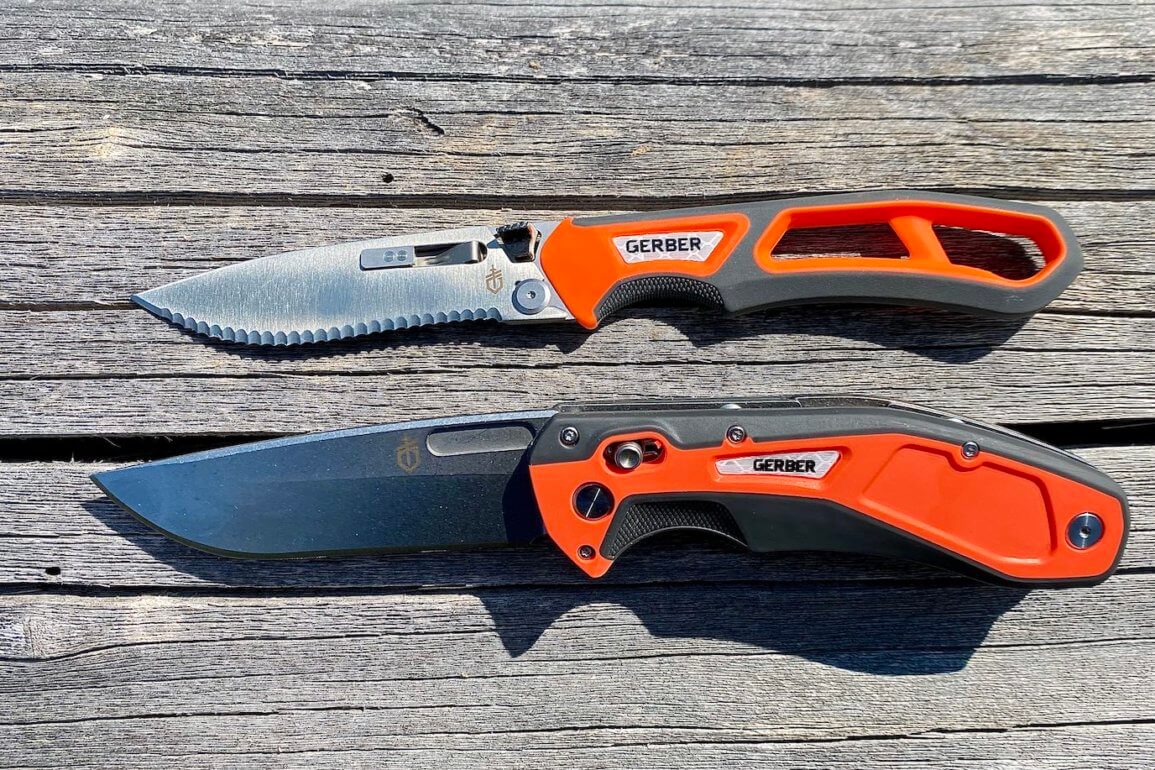After three years of development, Gerber Gear and Randy Newberg have introduced two new purpose-built elk hunting knives: The dual-knife DTS and the exchangeable-blade EBS.
To get us a closer look, Gerber sent Man Makes Fire a review unit of each. After examining both knives and doing a video conference call with Randy Newberg, this is what we learned:
The New Gerber ‘Randy Newberg’ Knives
During our archery elk season opener here in Idaho, my hunting partner and I did not get a chance to use either of these knives on an elk — but the season isn’t over. In the event that I’m able to put them to real-world work this season, I’ll update this review. In the meantime, the new Randy Newberg knives are hot knives this year and we know you want to learn more.
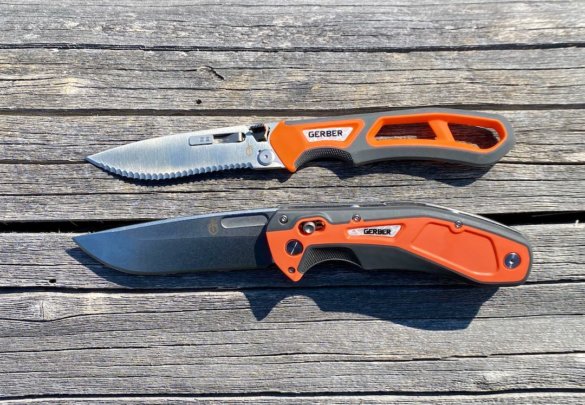
We’ll start with the development process, then dive into the features of each knife and how they came to be.
A lot of products get developed by a company . . . and then some sort of industry star gets attached to the product after it was developed — just to help market the product. The new EBS and DTS Randy Newberg Signature Series knives are the exact opposite of that.
In fact, the development process spanned three years. Over that time, Newberg traveled to Gerber headquarters in Portland, Oregon a half dozen times for jam-packed 2-3 day product development sessions. Along the way, Gerber also sent Newberg dozens of prototypes to test at home in Montana and out on hunts.
If you don’t know Randy Newberg, that’s ok, but if you’re a public land hunter, you should know him. Newberg produces a public land hunting video series called Fresh Tracks, which has eight seasons available on Amazon Prime. He also does the Elk Talk podcast with Corey Jacobsen, the Hunt Talk Radio podcast, does live video Q&A sessions on his channels on YouTube, Facebook, and Instagram, and manages the Hunt Talk discussion forums. He’s been trapping since he was a kid and hunting for decades. Despite being a possibly mild-mannered accountant by trade, he has an indefatigable enthusiasm for hunting on public lands.
Basically, the knife development process came down to this: If Newberg was going to put his name on a knife, it needed to be a knife that he wanted to use himself out in the wild.
Gerber became the partner that wanted to get it right, too.
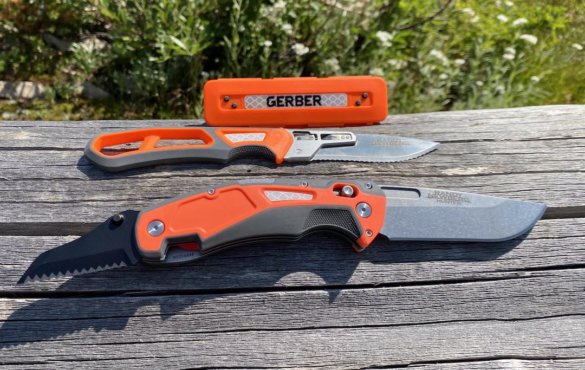
The Vision? One Knife. The Answer? Knives.
Elk hunters need specific knives because elk are big and require more work to process than deer and most game. More importantly, elk are often harvested far off the beaten path. They’re hard to drag to a vehicle, and that means elk often need to be quartered and packed in a backpack.
One challenge is getting through the field processing of an elk without spending time sharpening your knife. It’s all a lot of work and usually requires a lot of effort to pack an elk out. Even Newberg, who knows how to sharpen knives, doesn’t want to be spending any extra time sharpening when it’s 20 degrees outside — or when he’s in grizzly country with an elk down.
The key to both the DTS and the EBS are multiple blades in each knife.
The way to use them is to use a primary blade for softer tissue, and instead of damaging that primary edge on bone, tendon, and dorsal hide and hair, you can use a dedicated blade for the roughest work.
The result is that you should be able to use each knife to field process three elk using the gutless method without needing to resharpen your blades.
If you think that standard is a bit much, rest assured, Newberg put the prototypes to the test over multiple hunting seasons. In last year’s season, he used the DTS to field dress, via the gutless method, six animals without needing to resharpen the knife: a moose, a caribou, three elk, and a wolf.
Let’s take a closer look at the design elements of each knife:
Randy Newberg DTS Review: Up Close
The first thing you’ll notice when you hold that DTS is that it’s a beefy knife. It’s big with a big primary blade made from 440C steel. The backside of the blade is relatively thick, and the pivot lock is super solid. Why so rugged? While Newberg almost always uses the gutless method, some hunters prefer an open cavity method and they often split pelvic bones with their knives. So the DTS is a bit overbuilt just in case.
The first thing I noticed about the DTS was its relatively open frame design. Why is this important? It makes clean up way easier. For a knife this rugged and comfortable to hold, it’s remarkable how open it is.
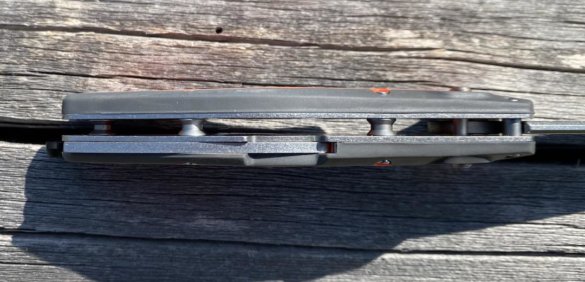
The size of the DTS brings up a few points: While testing prototypes, Randy would walk around his house carrying and squeezing each knife in his hand for a couple of hours. Watching a football game? He’d be holding a knife. Other than freaking out his wife, what gives?
The guy is dedicated. If there was any part of the handle that would bother you after two hours, Newberg would find it and the Gerber team would adjust it.
The key point for all of us elk hunters is that Newberg took this seriously. And we’ve all, at some point, spent two hours processing an elk in the field.
The key for us, though, is that Newberg helped eliminate prototypes and tweaked the actual shape of the handles. For instance, Gerber sent Newberg versions with multiple sizes and and shapes of the handle, in particular, with different shapes of index finger grooves, which helps with control and comfort. The particular depth and shape that made it into the final product survived field testing, including tests with Newberg’s crew and other hunters with differently sized hands and preferences.
Shop the Gerber Randy Newberg DTS at Cabela’s and get FREE 2-Day Shipping!
No Pocket Clip!
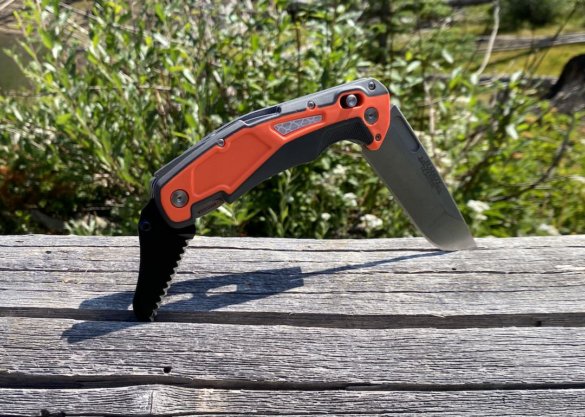
Speaking to that comfort, there’s no pocket clip on either knife. While I like a good pocket clip for an everyday carry knife, I would never carry my primary hunting blade in my pocket with a clip — I would lose the knife scrambling through Idaho brush on steep ground. No doubt about it. Every elk hunter I’ve known does not use pocket clips with any hunting knives. They’ve all lost something in the backcountry so they know what I’m talking about.
But this lack of feature is something Newberg is particularly proud of because, as it turns out, many big box stores refuse to stock hunting knives that don’t have pocket clips. Seems absurd, but it’s a quirk of consumers, retailers, and the industry. Newberg actually spent time pitching the lack of a pocket clip to key retail representatives so they would stock the Gerber knives when it came time to put in their orders. Wow.
The Tendon Tool
At the start of the development process, Newberg says the premise was to create one knife that could provide all the answers for an elk hunter in the field.
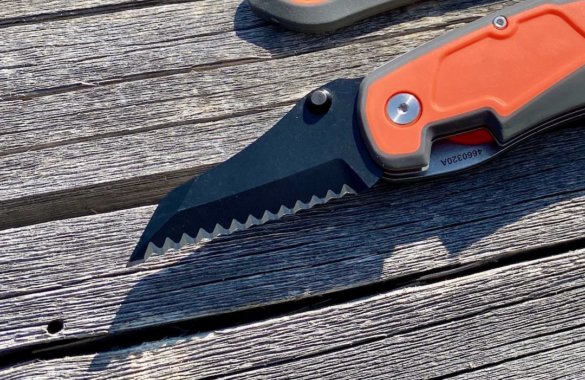
“I wanted to try to solve everything with one knife, and the exchangeable blade system was where I thought we could solve it,” Newberg recalls, noting that he didn’t expect the folding-style knife prototypes to make the cut until Gerber engineers came up early Tendon Tool prototypes.
In fact, the Tendon Tool idea highlights the frequent back-and-forth effort of the collaboration process. Here’s what happened: A Gerber engineer watched footage of Newburg processing animals in the wild and he noticed that Newberg sometimes used a knife with a serrated blade. Gerber didn’t make a serrated hunting blade at the time. So, what was that knife?
“I was using an old Cutco knife I’ve had for 25 years,” Newberg says.
Consequently, the design effort shifted to include a serrated blade with the knife that became the DTS — the Dual Tool System version. But even that little blade included a surprising level of development.
“For the prototypes, they sent one with a hook, one shaped like a bottle opener, and those didn’t work,” Newberg says. “I think the final version is about derivative number eight.”
That version not only needed to be tough with an edge that would last nearly forever, it needed to be strong — and yet have a shape able to handle tough elk-hunter tasks.
“The hardest job on an elk is removing the head from the spine at the atlas joint. That’s where you’re going to break a blade if you’re going to break one,” Newberg says.
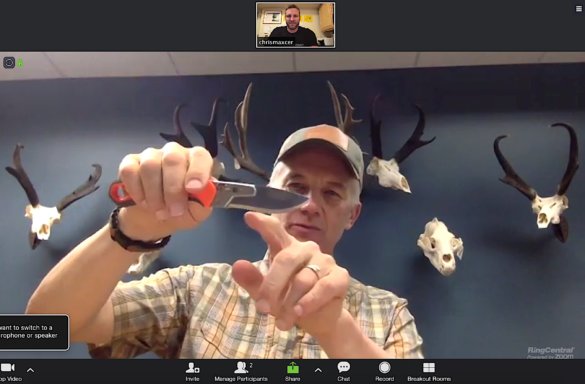
Back at the Gerber laboratories, Newberg tested several of their knives on different jigs with different angles and cracks that could replicate the stress of the atlas joint under real-world situations. “So I’d test a knife and ‘ping!’ the blade would break,” Newberg says.
The resulting Tendon Tool, as they call it now, has a pointed but reinforced shape. Newberg says he’s not sure what kind of steel it’s made out of, but says, “It’s the steel they use to cut other steel.”
The point? The Tendon Tool is designed to be sharp and effective for a very long time.
Shop the Gerber Randy Newberg DTS at Cabela’s and get FREE 2-Day Shipping!
Randy Newberg EBS Review: Up Close
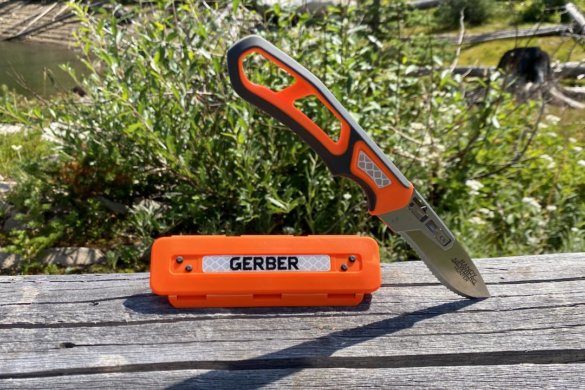
Personally, I’ve been using exchange-a-blade systems to great effect for the last decade. These are knives that basically hold large razor-like scalpel-type blades. Once a razor blade becomes dull, you simply wrap it up carefully to throw away later and replace it with a new sharp disposable blade.
The downside, of course, is that these blades are not very strong and don’t last very long before they need to be replaced. If you run out of blades, you’re screwed. (Which is why I always carry a backup knife.)
How could Gerber and Newberg improve upon the razor-blade systems that are already available? First, the system needed to be burlier to better deal with elk and difficult situations. It also needed to be lightweight. And the blades needed to be replaceable, but not intended to be disposable.
Consequently, the EBS has three blades that are all stouter than most other razor-type blade systems. You get three blades with the EBS: a 4-inch backstrap blade, a 3-inch caping/breakdown blade, and a 3-inch multi-purpose serrated blade.
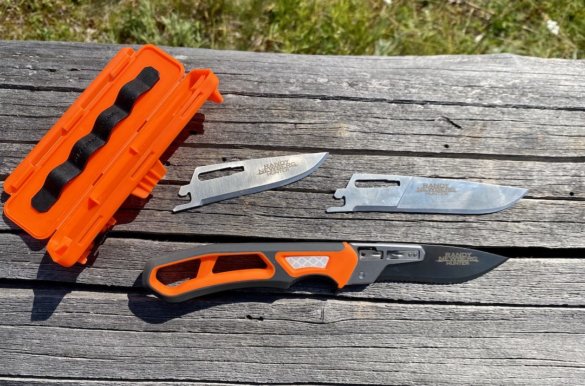
Gerber chose to use 440C steel. Most people will be able to sharpen the two plain edged blades. You can use a simple pull-through sharpener if you’re not skilled. I’m not sure about sharpening the serrated blade. Like the DTS Tendon Tool, the point is that you shouldn’t have to sharpen the EBS serrated blade for quite some time.
Either way, Newberg reports that EBS buyers seem to be purchasing extra EBS blades just to have extras.
The handle is skeletonized to reduce weight, and it also has a rubbery edge with a comfortable groove for your index finger.
The exchangeable blade system — the method for attachment and replacement — is super easy to use. Plus, it’s very stout. You’ll be able to put quite a bit of pressure on the system without breaking it (but it’s not as stout as the DTS).
Secret to Using the EBS
All exchangeable blade systems can be dangerous to use in the dark when your hands are cold and slippery and you’re exhausted. The secret to using the EBS is to hold the handle in your right hand when you exchange blades — and use your right thumb to press in the locking mechanism. If you don’t do this, it’s going to be hard to get the blade inserted (and impossible to get it out).
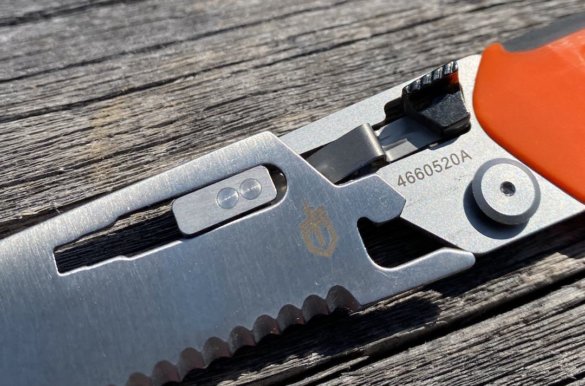
If you remember to press the lever with your thumb, the system works fantastically well.
The EBS comes with an orange carrying case that holds three blades. The EBS handle snaps securely onto the outside of the blade case.
At one point during testing while hunting on a mountaintop, Newberg remembers hearing the EBS blades rattling as he walked. He called the Gerber team while out there and said, “Ah, this isn’t going to work, guys.” Newberg was pretty sure they were getting tired of his feedback, but the result was that Gerber came up with the innovative wavy rubber interior element of the case. The rubber secures the blades inside the case no matter how you stack the differently sized blades. I can attest: It’s silent.
Shop the Gerber Randy Newberg EBS at Bass Pro Shop and get FREE 2-Day Shipping!
Retroreflective Material?
The one feature that instantly had a buddy geeking out was the reflective strips in the handles. If you’ve ever processed and elk or deer at night, you or a friend have probably lost a knife in the dark — at least temporarily, if not forever.

Obviously, a headlamp or flashlight will illuminate reflective material and help you recover your knife. But Gerber took it another step by using retroreflective material. This stuff is multi-dimensional on the inside of the strip, which lets it reflect light directly back toward its source. The result is that the material is reflective over wide angles, which makes it much easier to spot.
DTS vs EBS: Choose Your Newberg
All-in-all, I haven’t had a chance to field test Gerber’s new Randy Newberg DTS and EBS knives on elk — but I hope to this hunting season. What I can tell you so far is this: Both offer a pretty sweet value proposition. Both knives cost about $60, which is a great value. To be able to process three elk without resharpening is also cool. Both are rugged and rubberized, and surprisingly, weigh nearly the same. The DTS weighs 6.6 ounces while the EBS weighs 6.01 ounces.
If I were pick just one, I’d go for the DTS because of the Tendon Tool. I hope to harvest elk far off the beaten path. That means I’ll need to break down an elk so I can more easily carry it out with my backpack. If the Tendon Tool will work for me like Newberg says it works for him, that’ll be hard to beat.
On the other hand, the curved shape of the serrated blade should make short work of tendons and tough dorsal hide. I like the size and shape of that blade, and I like the size of the longer backstrap blade, too.
Because the knives are so new — and built strong enough for all big game — the Newberg Signature series knives will make great gifts for hunters and/or gifts for bowhunters this year. I’ll be carrying both this season and will report back. In the meantime, both knives are solid and sharp out of the box. Highly recommended.
Get the Gear:
Check shipping/pricing: Amazon | Bass Pro Shops | BlackOvis | Cabela’s | CampSaver | Gerber
Check shipping/pricing: Amazon | Bass Pro Shops | BlackOvis | Cabela’s | CampSaver | Gerber
*Note: If you buy the EBS from Gerber direct, there is no affiliate commission available to Man Makes Fire . . . BUT for a limited time 10% of proceeds will go to the Rocky Mountain Elk Foundation, and that’s super cool. In addition, if you use promo code “RANDY” at check out at Gerber, you’ll save 20 percent!

